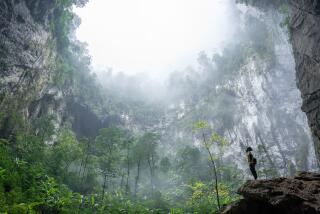Spelunkers Hit the Jackpot in Kentucky Cavern
- Share via
MONTICELLO, Ky. — In the misty darkness, Alan Glennon holds tightly to a rope as he carefully makes his way down about 20 feet of jagged, loose rocks.
His only light is the small lamp on his hard hat as he takes slow, careful steps down the rugged outcropping to the next level in the underground obstacle course of cliffs and mud and water.
“Rock,” he shouts to his climbing partner, as one of the stones clinks under his foot into the empty blackness.
They are among the first explorers experienced enough and small enough to squeeze through and see the prize that lies ahead-- perhaps the biggest cave passageway in Kentucky.
The newly discovered cave room is estimated to have a 90-foot ceiling and a floor space of 2.5 acres. By comparison, the largest room in Mammoth Cave is about 2 acres.
“It’s bigger than anything else we know about in the state,” said Chris Groves, an associate geography professor at Western Kentucky University in Bowling Green.
The entrance to the cave was discovered in 1996 by former Western Kentucky University student Art Pettit. Although he surveyed a portion of it, Pettit didn’t go very far in.
But he told Glennon and fellow cavers Joel Despain and Shane Fryer about the discovery. The trio decided a few months ago to go in and create a detailed map of the cave. After three months of work, Despain and Fryer found a jagged and narrow crawl space leading to something beyond their imaginations.
“We were hoping to find a big cave,” Fryer said. “We didn’t expect anything as big as we found.”
Although it’s a fascinating discovery, catching a glimpse of the big room isn’t the only reason the students have made the trek to Wayne County in southern Kentucky.
They have also come to learn. Geology and geography students from the university try to visit the area every couple of weeks to map and measure this cave and look for others. The students want to keep the exact location of the cavern secret to preserve its natural aspects. It is on private property about 100 miles south of Lexington.
So far, they have mapped a 4,000-foot path through the unnamed cavern along with Fryer and Despain. But there are still areas that haven’t been explored.
“A cave map is the first level to understanding a cave,” Glennon said.
That’s a basic part of trying to conserve and protect one of the state’s natural resources, Groves said.
The studies of cave systems and how they work can also help researchers better understand water quality and supply problems, Groves said. Much of the state’s drinking water comes from streams that run through caves.
The discovery might also help other caves in the region by bringing more attention to their importance, said Vicki Carson, a spokeswoman for Mammoth Cave. “They are delicate places, and they need protection.”
Fryer said it was special to be one of the first people to see such a big passageway.
“We just sat there for a while looking around,” he said. “We were just awe-struck.”
That expedition led to the recent trip by Glennon, a geology graduate student at Western Kentucky, and Rhonda Pfaff, a university senior studying geography. The pair took along a reporter as they continued mapping some of the untouched parts of the cave.
“You want to meet the cave on its own terms,” Glennon says as he makes sure there are three light sources per person, extra batteries, water, food, gloves and knee and elbow pads.
Glennon and Pfaff make it the final 300 feet only after a grueling six-hour trip. They climb over big chunks of broken rock. They crawl on hands and knees over rough stones. They climb carefully up mud banks that slide down into cold waist-deep water. They inch slowly around crevasses that fall into blackness. They squeeze through small passageways where rock closes in so tightly that they can barely raise their heads to see where to go next.
When he gets to the final obstacle, Glennon, who has been caving for 18 years, seems a little surprised by what he finds. He was expecting to have to crawl through a small, tight passageway to get to the large room of the cave. But he finds something a little different.
“This isn’t a belly crawl,” he says after getting only a few feet in. “It’s a contortionist crawl.”
Pfaff, who has been exploring caves for about two years, follows him only so far before deciding that it isn’t worth going any farther.
Glennon pushes on, crawling the crooked, winding length of a football field through jutting rocks that press tightly against his chest. His first reaction to finding the place where the cave opens up into a big room, Glennon says, is relief that he isn’t being squeezed between the rock anymore. Then curiosity takes hold as he looks around.
Carefully, Glennon works his way from one car-sized rock to another while listening to the babble of a stream below. It isn’t until he gets into the middle of the passageway and turns around that the enormity of the room really hits him.
“There was blackness in both directions,” he says.
Over the next few months, Glennon and the others will continue to map the cave to find out what, if anything, lies beyond the big room.
Although Glennon has seen bigger passages in other caves in other parts of the country, he said, he feels a special attachment to this one.
“It’s very exciting because it’s a cave I started mapping right from the entrance,” he said. “This is one I was a part of.”
More to Read
Sign up for The Wild
We’ll help you find the best places to hike, bike and run, as well as the perfect silent spots for meditation and yoga.
You may occasionally receive promotional content from the Los Angeles Times.






